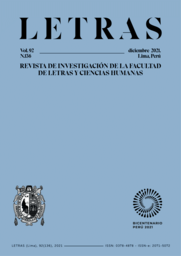Modes, Forms and Mechanisms of Violence in Memoirs of an Unknown Soldier by Lurgio Gavilán Sánchez
Abstract
Among the literary representations of the recent Peruvian past, a generation of writers who had suffered Internal Armed Conflict (1980-2000) during their childhood, stands out. Lurgio Gavilán Sánchez, writer and anthropologist, participated as a child soldier in the armed conflict first in Sendero Luminoso and then as a corporal in the Army. This article will analyze the dimensions, ritualization and protocols of violence on both sides in his work Memorias de un soldado desconocido. Autobiografía y antropología de la violencia, published by the Institute of Peruvian Studies in 2012. Thus, we will examin the aesthetic elaboration of violent situations and the mechanisms of erasure, silencing and distortion exhibited by the author that evidence the tension between writing and experience. The notion of memory (Jelin, 2002; Todorov, 2000) that underlies Gavilán Sánchez’s writing supposes the reconstruction of a life trajectory that inflects the individual and the collective, the experience and the writing, the public and the private. His memoirs present a textual self-configuration intertwined in different autobiographical rhetorical modes that account for a violent past from a position oscillating between the figures of victim and victimizer.Downloads
Métricas alternativas
References
Arfuch, L. (2010). Sujetos y narrativas. Revista Acta Sociológica, 53, 19-41. https://doi.org/10.22201/fcpys.24484938e.2010.53.24297
Castro Neira, Y. (2012). Antropología de la violencia. Entre los estudios del sufrimiento social y la antropología de la paz. Memorias de un soldado desconocido. Autobiografía y antropología de la violencia (17-48). Instituto de Estudios Peruanos, Universidad Iberoamericana.
Comisión de la Verdad y Reconciliación (CVR). (2003). Informe final. Lima: CVR. http://cverdad.org.pe/ifinal/.
Degregori, C. I. (2000). Discurso y violencia política en Sendero Luminoso. Bulletin de l’Institut Français d’Études Andines, 29(3), 494-513. https://www.ifea.org.pe/libreria/bulletin/2000/pdf/493.pdf
Degregori, C. I. (2010). El surgimiento de Sendero Luminoso. Ayacucho 1969-1979. Instituto de Estudios Peruanos.
Degregori, C. I. (2012). Sobreviviendo el diluvio. Las vidas múltiples de Lurgio Gavilán. Memorias de un soldado desconocido. Autobiografía y antropología de la violencia (9-16). Instituto de Estudios Peruanos, Universidad Iberoamericana.
De Vivanco, L. (2020). Como el río subterráneo. Conversación con Lurgio Gavilán Sánchez. MERIDIONAL Revista Chilena de Estudios Latinoamericanos, 15, 221-235. https://doi.org/10.5354/0719-4862.2020.58660.
Gavilán Sánchez, L. (2012). Memorias de un soldado desconocido. Autobiografía y antropología de la violencia. Instituto de Estudios Peruanos, Universidad Iberoamericana.
Huyssen, A. (2000). En busca del tiempo futuro. Puentes, 1(2).
Jara, U. (2003). Ojo por ojo. La verdadera historia del Grupo Colina. Grupo Editorial Norma.
Jelin, E. (2002). Los trabajos de la memoria. Siglo XXI editores.
Lejeune, P. (1991). El pacto autobiográfico. Revista Anthropos, 29, 47-61. https://semioticaderedes-carlon.com/wp-content/uploads/2018/04/Lejeune.pdf
López Maguiña, S. (2007). Poder y compromiso en el discurso de Sendero Luminoso. Revista Ajos y Zafiros, 8/9, 14-30.
López Maguiña, S. (2016). Discursos de la purificación y la limpieza en la narrativa literaria sobre la guerra interna. En C. Vargas-Salgado (Ed.), Conflicto armado y políticas culturales de la memoria en el Perú (68-83). Hispanic Issues On Line 17. https://bit.ly/3l3FC1F
Lust, J. (2018). La justificación del uso de la violencia revolucionaria: Un análisis de las organizaciones guerrilleras peruanas de las décadas de 1960 y 1980. Revista Telar, 21 (12), 57-92. http://revistatelar.ct.unt.edu.ar/index.php/revistatelar/article/view/405.
Nora, P. (1996). General Introduction: Between Memory and History. En P. Nora (Dir.), Realms of memory. The Construction of the French Past. I Confticts and Divisions (1-20). Nueva York: Columbia University Press.
Portocarrero, G. (2015). Profetas del odio. Raíces culturales y líderes de Sendero Luminoso. Fondo Editorial de la Pontificia Universidad Católica de Perú.
Salazar Jiménez, C. (2016). Escrituras del yo y políticas de la memoria: Recepción y circulación de los textos de Lurgio Gavilán y José Carlos Agüero. Revista Letras Hispanas, 12, 171-183. Recuperado de https://bit.ly/2Yjxsd2.
Segato, R. L. (2003). Las estructuras elementales de la violencia. Ensayos sobre género entre la antropología, el psicoanálisis y los derechos humanos. Bernal: Universidad Nacional de Quilmes.
Todorov, T. (2000). Los abusos de la memoria. Barcelona: Paidós.
Ubilluz, J. C. (2021). Sobre héroes y víctimas. Ensayos para superar la memoria del conflicto armado. Lima: Taurus.
Copyright (c) 2021 Letras (Lima)

This work is licensed under a Creative Commons Attribution 4.0 International License.
Este obra está bajo una licencia de Creative Commons Reconocimiento 4.0 Internacional



















